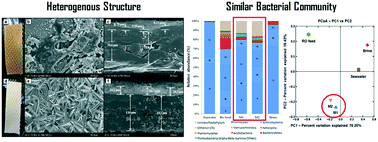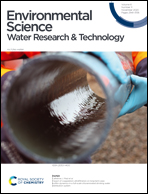Structural heterogeneity yet high similarity of the microbial community on reverse osmosis membrane-driven biofilms during seawater desalination†
Abstract
Reverse osmosis (RO) membrane biofouling is a critical issue in seawater desalination. However, biofouling characteristics are not fully understood owing to the complex structure of the fouling layer. Therefore, the objective of this study is to investigate how the biofouling characteristics of RO membranes are associated with bacterial and archaeal communities and their physiological (surface structure, elemental composition, and thickness) and metabolic characteristics in different locations of the RO membrane element. Raw seawater, feedwater, first- and last-located RO membrane elements, and brine were collected from a full-scale (50 m3 per day) intermittently operated seawater reverse osmosis (SWRO) desalination plant. Bacteria were found to be the most dominant biofouling microorganism on the RO membrane surface rather than archaea or diatoms. This study highlights that the very first element of the RO membrane receiving inflow had fouled biofilm with more heterogeneous morphologies and chemical composition compared with the very last element of the RO membrane where the outflow is discharged. In contrast, the microbial communities in both biofilms were similar to each other during the period of desalination operation. The most dominant bacterial species in the biofilm of RO membranes were Pelagibius, Parvibaculum, Legionella, Hyphomicrobium, and Sphingomonas. Moreover, their physiological and metabolic characteristics, such as salt tolerance, high pressure tolerance, and/or oligotrophic properties may provide advantages for their adaptation and dominance in RO membrane biofilms. A substantial difference in microbial diversity was observed between the feedwater and RO membranes, suggesting that more attention should be given to the biofilm, rather than the feedwater, when investigating how biofouling is developed and eventually controlled.



 Please wait while we load your content...
Please wait while we load your content...